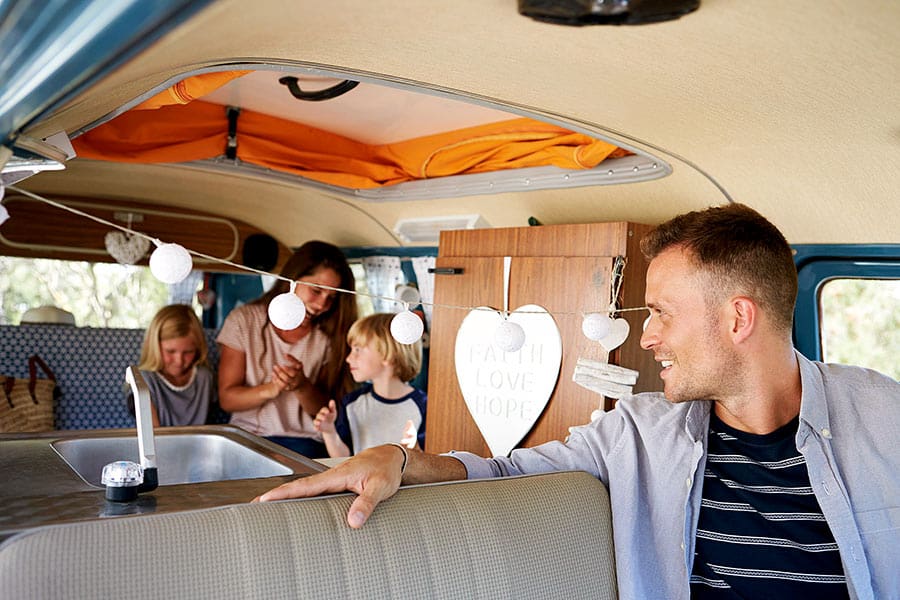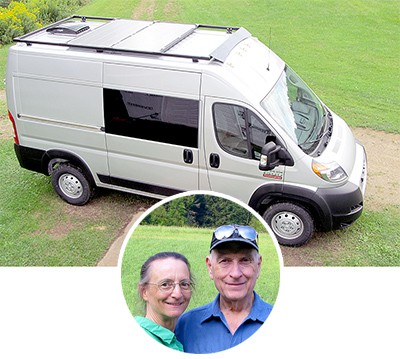
If you’ve got a camper van, you’re probably excited to get it out on the road. If you’re planning on taking more than one person along, you may wonder about the laws about letting passengers travel in the back. Since most camper vans are customizable and if you want passengers, you may be considering whether you need seats and restraints.
Can passengers travel in the back of a camper van? The safest option for having passengers in the back of a camper van is to install forward-facing seats with seat belts. While seat belt laws vary state-to-state, babies and young children must have proper car seats everywhere you go. For older children, it is essential to check laws to determine what kind of seats and restraints you’ll need.
Now that you know that seat belt laws apply to your camper van let’s learn more about how they affect the design of your van. It’s important to consider your travel destinations and classification of your vehicle since the rules can vary according to what you’re driving.
Considering Seating When Choosing A Camper Van
When choosing a van or RV, it is best to think about how many people plan to travel with you. Perhaps adults plan to travel as a couple most of the time but need space for children or friends for special trips. If you plan to customize your van, add seats for the maximum amount of people you may have riding with you in the future.
Sometimes seat belt enforcement depends on the age of the van. Older vans may not have modern seat belt options. In some areas, this can exempt you from prosecution. There is rarely lenience with children, however. You must find a way to secure them properly.
When choosing your van, find one with enough seats or design your layout to accommodate extra seats. Seats with seat belts can double as dining or lounge seating. Convertible beds can also turn into seats. You may also want to read our post on picking the perfect van here.
Think About The Comfort Of Your Passengers
Even if your state allows passengers to recline on the bed or floor, this is not always comfortable for long trips. You can add an extra row of bench seats behind the swivel seats in the front. You can leave space for a table in-between. When you reach your destination, turn the front seats around, install the table, and enjoy a relaxing meal.
Some tips for passenger comfort include:
- Be sure to add cushions for guests to enjoy while you drive.
- Taller seats with headrests feel better and keep you safer in a wreck.
- Sometimes extra seats back up to a wall, requiring the passenger to remain at a 90-degree angle the entire time. Try to avoid this.
You can have regular seats installed throughout the van. If you want a custom van, talk to the dealer or designer to figure out the best place for comfortable seats.
Know The Different State Laws For Vehicle Passengers
It is best to look up the strictest state laws before you choose a camper van. You may live in one state yet plan to travel across the country. Even if your license is from a lenient state, a traffic stop can cause trouble for you.
- Some states also define “child” differently. It is most common to refer to an 18-year-old as an adult when seat belt laws come into question. It is best to remain cautious and seat passengers age 18 and up as adults.
- In a few states, you must only use seat belts when available. Before you purchase a camper van, ask the dealership about seating options and laws in your area.
Sometimes people make their own rules and hope the authorities don’t catch them. A police officer can discover improper seating during a traffic stop. If you have an accident, passengers may incur serious injuries. Improper seating can leave the driver liable for any injuries and damage, especially if it is a child.
It is best to remain cautious when purchasing a van. Regardless of your state’s laws, plan a safe seating option for all passengers. If you would like to travel with a large group and do not have enough seating, you can have extra people follow behind in a different car.
Related Posts
- Camper Van Insurance: How Much Should You Spend?
- Are Camper Vans Expensive to Run? Let’s Break it Down
- Can Anyone Drive A Camper Van?
Your Best Option: Forward-Facing Seats
The safest position for riding in any vehicle is forward-facing; however, this is not the standard for many seats in camper vans and RVs.
Most camper vans have two forward-facing seats in the front. These come with proper seat belts. If you purchase a van with the intention of modifying it, you may have several rows of safe seating. You can plan your buildout around the seats that you need to keep.
You can also have forward-facing seats installed behind the front seats if your van does not have them. Swivel seats give you more options for use when you park the van. However, you can often custom design bench seats to convert into an extra bed.
If you plan to have a dining area, simply make sure some of the seats face forward for safe driving. Ask your dealership about seating options or design a custom seating area.
Backward And Side Facing Seats
It is common to have a few seats that face backward or sideways. It’s often legal to use these seats while driving. However, it is more dangerous if an accident occurs. These may have lap belts only and do not meet standards for child car seats.
You can get a dinette area with both forward-facing and rear-facing seats, which is a better option than having all your dining seats facing sideways. This configuration gives you the opportunity of having at least two more forward-facing passengers.
Sitting Up Front
Front seats must have proper three-point seat belts. Babies and young children should not sit up front. It is very dangerous for an airbag to deploy on a child or hit a car seat. Older cars may not have weight sensors for the airbag.
Most RVs or camper vans have two individual seats up front. If you plan to travel with kids, pick the model with the most forward-facing rear seat options. Consider swivel seats for the front of your camper van so you can use them for dining and watching television once you reach your destination.
Laws May Differ Depending On The Vehicle
The laws concerning seat belts for camper vans and RVs may vary depending on the class of your vehicle. You can determine what class of vehicle you have by looking at the weight.
- A Class B RV weighs between 6,000 and 8,000 pounds.
- A Class C vehicle typically weighs between 10,000 and 12,000 pounds.
- Class A campers usually range between 15,000 – 30,000 pounds.
Some states exempt seat belts in large RVs while others require only lap belts for certain classes. These exemptions never apply to front-seat passengers; laws only vary for rear seating.
With the many variables of each personal situation, it is best to consult the dealership and state law websites before you decide on a camper van.
Conclusion
You can have great family adventures in a camper van. It can take a lot of research to find the right one for your family. There are many sizes and layouts available. Custom camper vans work well for families with specific seating needs, as well.
Safety is a significant concern for everyone on the road. Before you begin your first trip, make sure you know the laws of the states you plan to visit. You should also purchase proper car seats for babies and children. Once your camper van is complete, get ready to explore!






